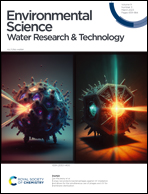Experimental study on progressive freeze-concentration based desalination employing a rectangular channel crystallizer
Abstract
This paper reports an experimental study on progressive freeze-concentration based desalination of saltwater to produce drinking water, irrigation water, and concentration-reduced brine waste. A vertically-aligned rectangular channel crystallizer was utilized for the study. In the crystallizer, the saltwater flows upward over the vertically aligned cooling surface kept at a temperature adequately below the liquidus temperature and produces ice. The thawing of ice provides diluted saltwater. A parametric analysis was conducted to explore the influence of saltwater flow rate (4400–5600 ml min−1) and initial saltwater concentration (1.5–15 wt%) on thawed ice and liquid concentration. The freezing–thawing stages required to produce drinking/irrigation water from seawater and concentration-reduced brine waste from brine without ice seeding were determined experimentally. It was found that three and four freezing–thawing stages are required to obtain irrigation and drinking water from seawater, respectively. The three-stage and four-stage freezing–thawing of seawater achieved salt separation efficiencies of 96% and 99%, respectively, at a seawater circulation flow rate equal to 5200 ml min−1 and a coolant inlet temperature equal to −9 °C. The multi-stage freezing–thawing process was adequate to separate the salt even from the brine (concentration of 5 wt% and above). After three stages, brine with an initial concentration of 10 wt% was desalinated to concentration-reduced brine waste of 2.2 wt% concentration. The three-stage freezing–thawing of brine achieved a salt separation efficiency of 78%.



 Please wait while we load your content...
Please wait while we load your content...